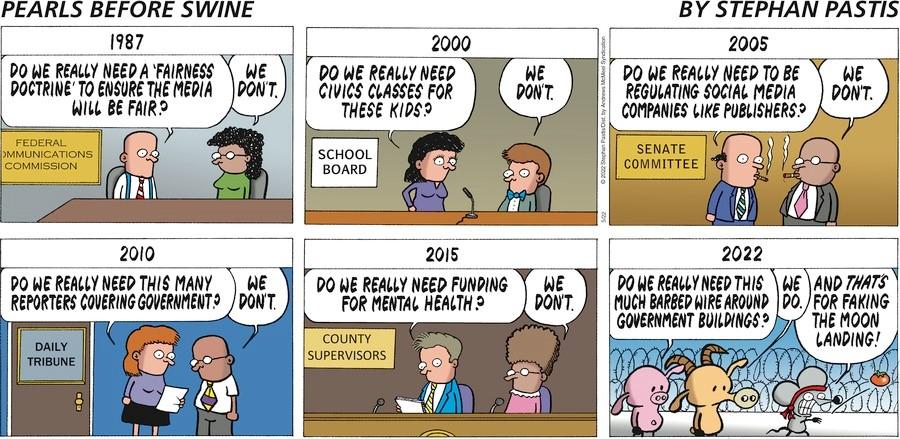
16 Jul Supreme Reality
“Today’s Supreme Court is the most influential branch of America’s government … and also its most active.” – The Lonely Realist
America’s Congress is riven by partisan squabbling rendering it unable to fulfill its legislative obligations. America’s Presidents consequently have resorted to executive orders issued without Congressional approval, exceeding their Constitutional authority and leading America’s courts to block their application. The absence of legislative + executive agreement – government gridlock – has gutted effective Federal law-making. This has empowered the Supreme Court to fill the void by itself engaging in law-making (and also by delegating law-making to the States), a responsibility that the Founders believed had been entrusted solely to the combination of Congress and the President. The Court accordingly has been activist with respect to a broad range of legal and Constitutional questions …, often reaching decisions that are inconsistent with decades of judicial practice and precedent. President Trump promised to change the Court. He and Mitch McConnell delivered! The pendulum now is swinging. How far it will go and which direction(s) it will take are not clear.
The First Amendment states that “Congress shall make no law respecting an establishment of religion….” Thomas Jefferson characterized the Establishment Clause as a “wall of separation between church and state.” President Trump supported taking bricks from that wall (for example, here) and, not surprisingly, appointed Justices with similar views. It is those Justices who now are tearing down the wall (and who also are in the process of hammering on other Constitutional walls). The consequent ruptures evidence neither a true “conservative” nor a true “liberal” tilt. They impact the left, the right and those in between.
On the separation of church and state, two cases decided by the Supreme Court have changed the scope of First Amendment rights. In Carson v. Makin, the Court held that Maine must fund religious education at private religious schools as part of its tuition assistance program. Carson is the first case requiring government support (that is, the use of tax dollars) for a specifically religious activity, a ground-breaking precedent. A week later, in Kennedy v. Bremerton School District, the Court held in favor of a high school football coach who had lost his job by insisting on his right to pray with students after games at the 50-yard line, upholding the right of government employees to engage in religious activities in a public workplace (the Court basing its decision on the preeminence of free speech over the separation of church and state), ignoring a line of cases holding that prayer in public schools is coercive and therefore violative of the First Amendment.
These two decisions followed on the heels of the Court’s landmark decision in Dobbs v. Jackson Women’s Health Organization, overruling Roe v. Wade. As readers of TLR know, TLR favors a strict constructionist approach to Constitutional interpretation, believing that the Constitution should be read literally and consistently. The reason for TLR’s belief in strict construction is not because States Rights should be exalted over Federalism or because the Founders had a clear preference for undelegated powers to revert to the States. Rather, the Constitution is not an infinitely malleable instrument that the courts should use to alter the policies adopted by America’s executive and legislative branches. Legal stability and the Rule of Law – that is, consistency of application and enforcement – are vital to the effective functioning of America’s capitalist democracy … as well as an integral component of a functional society. Laws “legislated” through judicial activism undercut democracy. Unfortunately, the inability of Congress and the President to agree on policy and take consensual action has led the Supreme Court to do just that. Chief Justice Roberts previously had successfully steered the Court in an institutionalist direction that ensured consistency, a cornerstone of which had been adherence to the legal doctrine of stare decisis (which requires courts to treat prior decisions as binding, not to be disturbed except to rectify an egregious wrong or to account for changes in societal norms). As TLR previously noted, reversing existing precedent means that those who structured their lives and businesses in reliance on that precedent have to adjust, often with adverse personal, societal and economic consequences. Legal predictability and stability are vital elements of America’s success and an integral component of a functional national society. It is for that reason that judicial activism is very much to be avoided … though not, apparently, any longer.
The Supreme Court during its most recent term has definitively abandoned stare decisis, adopting an approach to jurisprudence that not only ignores existing precedent but also charts an activist course …, and not only with respect to the First Amendment’s separation of church and state, but also with respect to the Fourteenth Amendment’s assurance of abortion rights (the Dobbs decision), gun rights (New York State Rifle & Pistol Association v. Bruen), the executive branch’s latitude in interpreting Congressional legislation (West Virginia v. Environmental Protection Agency), Miranda warnings (Vega v. Tekoh), the Sixth Amendment’s right to capable counsel (Shinn v. Ramirez), habeas corpus petitions (Brown v. Davenport), and private rights of action regarding government violations of the Fourth Amendment (Egbert v. Boule) (a summary of the Court’s recent decisions can be found here). Importantly, the Court has parted ways with the judicial philosophy that for 50+ years guided successive Chief Justices Burger, Rehnquist and Roberts (all of whom were Republican appointees). The essence of that philosophical change can be found in Justice Thomas’ concurring opinion in Dobbs, where he called on his Supreme Court brethren to deviate further from existing precedent by “reconsidering” Supreme Court decisions regarding personal and familial rights (e.g., contraception and same-sex relationships). He indicated that the Court has a duty to “correct the error” established in those cases.
Can there be a clearer example of “judicial activism”?
The Supreme Court’s actions are a reflection of the political times. For example, the first question Senator Lindsay Graham, the senior Republican Senator on the Judiciary Committee, asked of Supreme Court nominee Ketanji Brown Jackson was “What faith are you?” Doug Mastriano, the Republican candidate for Governor of Pennsylvania, has described the separation of church and state as a “myth,” adding that in this November’s election “we are going to take our state back, my God will make it so.” And Representative Lauren Boebert has called the First Amendment’s separation of church and state “junk,” adding that, contrary to the Constitution’s Bill of Rights, “The church is supposed to direct the government.” Even though that’s a belief held by a small minority of Americans, it appears that it may be one now held by a majority of Supreme Court Justices.
Unrecognized by many Americans, America’s system of government therefore has undergone profound change … and not because President Biden may be advocating a socialist agenda or former President Trump may have attempted a violent coup. A more long-term change results from a reconstituted, radicalized Supreme Court. President Trump appointed Justices Gorsuch, Kavanaugh and Barrett. They, along with Justices Thomas and Alito and Chief Justice Roberts, form a 6-3 majority at least 5 of whom favor aggressively reversing the course of American law. As TLR has written, responsibility for the radical devolvement of power to the Supreme Court ultimately rests with Congress, because Congress has consistently abrogated its Constitutional obligations. The powers allocated to each branch of American government are the foundation for America’s democracy. Their proper exercise is essential to ensuring its functionality and durability. Whether you’re a strict constructionist or favor originalism or judicial activism, America’s democratic system requires that there be a balance of power among the three branches of government. There currently is an imbalance – disproportionate power resides in what today is an activist Supreme Court.
TLR Index
An index of TLR titles can be found here.
Finally (from a good friend)
Five Surgeons in a Bar:
Five surgeons from big cities are discussing who make the best patients to operate on.
The first surgeon, from New York, says, “I like to see accountants on my operating table because when you open them up, everything inside is numbered.”
The second, from Chicago, responds, “Yeah, but you should try electricians. Everything inside them is color coded.”
The third surgeon, from Dallas, says, “No, I really think librarians are the best. Everything inside them is in alphabetical order.”
The fourth surgeon, from Los Angeles, chimes in: “You know, I like construction workers. Those guys always understand when you have a few pieces left over.”
But the fifth surgeon, from Washington DC, shut them all up when he observed: “You’re all wrong. Politicians are the easiest to operate on. There’s no guts, no heart, no balls, no brains, and no spine. Plus, the head and the ass are interchangeable.”




No Comments